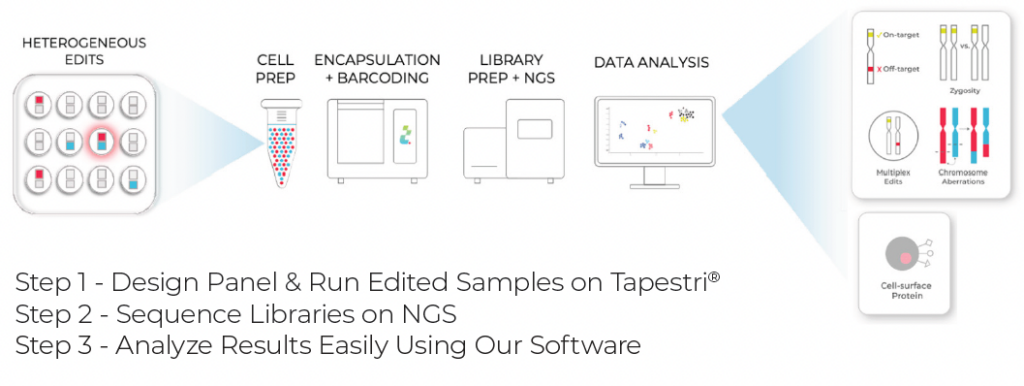Genome editing has emerged as a powerful tool for developing new cell therapies. With the ability to precisely modify genes, researchers can engineer cells with enhanced therapeutic properties or correct genetic defects that cause diseases. The first CRISPR-modified therapy is now under regulatory review, and many similar cell-based therapies are expected to follow for multiple intractable diseases. However, genome editing can result in complex, heterogeneous mixtures of edits that make it challenging to apply a level of process control over genome-edited cell products.
The success of genome editing depends on accurate and comprehensive analysis to ensure that the edited cells are safe and effective. Here we discuss the importance of genome editing analysis for cell therapy development and how single-cell analysis enables critical measurements for genome editing.
What is genome editing?
Genome editing involves the precise modification of DNA at specific locations in the genome using nucleases such as CRISPR/Cas9 or TALENs. The goal of genome editing in cell therapy development is to engineer cells with enhanced therapeutic properties, such as improved targeting of cancer cells or enhanced immune function. However, genome editing can also introduce unintended mutations and off-target effects which can affect the safety and efficacy of cell therapies. Additionally, multiplexed editing (the introduction of edits at two or more specific DNA loci) results in varying efficiency, zygosity, and co-occurrence. Therefore, accurate analysis of genome editing is essential for the development of safe and effective cell therapies.
Traditionally, genome editing analysis has been performed using bulk sequencing methods, which provide an average measurement of genome editing efficiency and specificity across a population of cells. However, bulk sequencing methods cannot provide information about the heterogeneity of genome editing within a population of cells, which can affect the safety and efficacy of cell therapies. This heterogeneity includes varying co-occurrence of edits, zygosity, and on- and off-target edits. Single-cell analysis methods, such as the Tapestri Platform, enable researchers to analyze individual cells and measure genome editing efficiency and specificity with high accuracy and resolution.
Meet the Tapestri® Genome Editing Solution
The Tapestri Platform uses microfluidics to isolate single cells and perform targeted DNA sequencing. Tapestri enables high-throughput and high-resolution analysis of genome editing at the single-cell level. The Tapestri Platform can analyze thousands of individual cells to identify rare events such as off-target effects, as well as zygosity and co-occurrence of on- or off-target genome edits which may affect the safety and efficacy of cell therapies.

The Tapestri® Genome Editing Solution workflow.
In addition to improving the measurement of genome editing in cell therapy development, single-cell analysis has also led to a better understanding of the biology of edited cells. Single-cell analysis has revealed the heterogeneity of edited cells, which can affect their function and response to treatment. By analyzing individual edited cells, researchers can identify subpopulations of cells with distinct characteristics and develop strategies to optimize cell therapies.
The analysis of genome editing is critical for the development and optimization of cell therapy applications. Mission Bio is excited to be developing the Tapestri Genome Editing Solution– a complete end-to-end solution, from panel design, assay, and analysis that can measure gene editing outcomes at single-cell resolution, capturing the co-occurrence of on- and off-target edits, as well as the zygosity of edits. Additionally, this analysis can be completed within days by processing thousands of cells at a time without any prior selection, while conventional analytical methods require months for clonal outgrowth.
“….Given the heterogeneous results of gene editing strategies, there is a great need to address both industry and regulatory genome editing concerns with a consistent and highly precise technology for accurately measuring gene editing outcomes, and our new offering will be a complete solution to do just that.” —Todd Druley MD, PhD, Chief Medical Officer, Mission Bio
The use of single-cell analysis, particularly on the Tapestri Platform, can greatly improve the accuracy and resolution of these measurements, leading to safer and more effective cell therapies. The Tapestri Genome Editing Solution will be released later this year and has already been used by leading cell therapy developers in industry, academic, and government laboratory settings.











